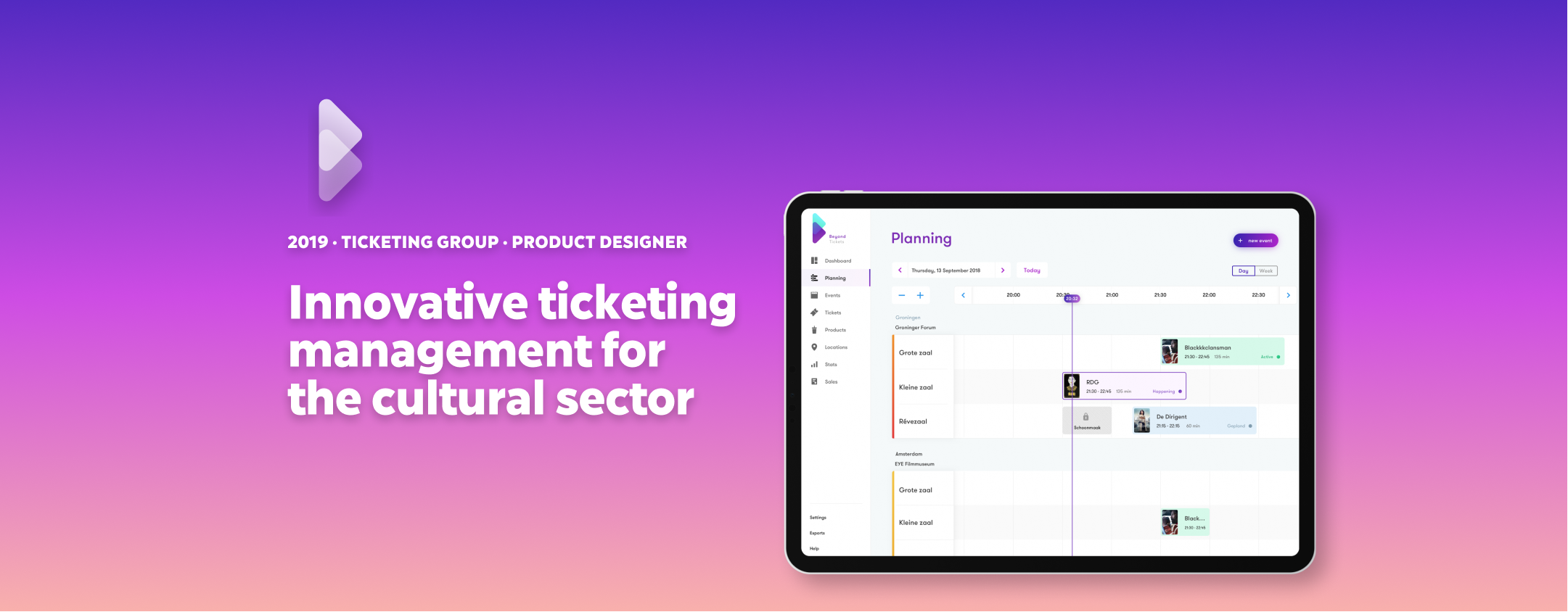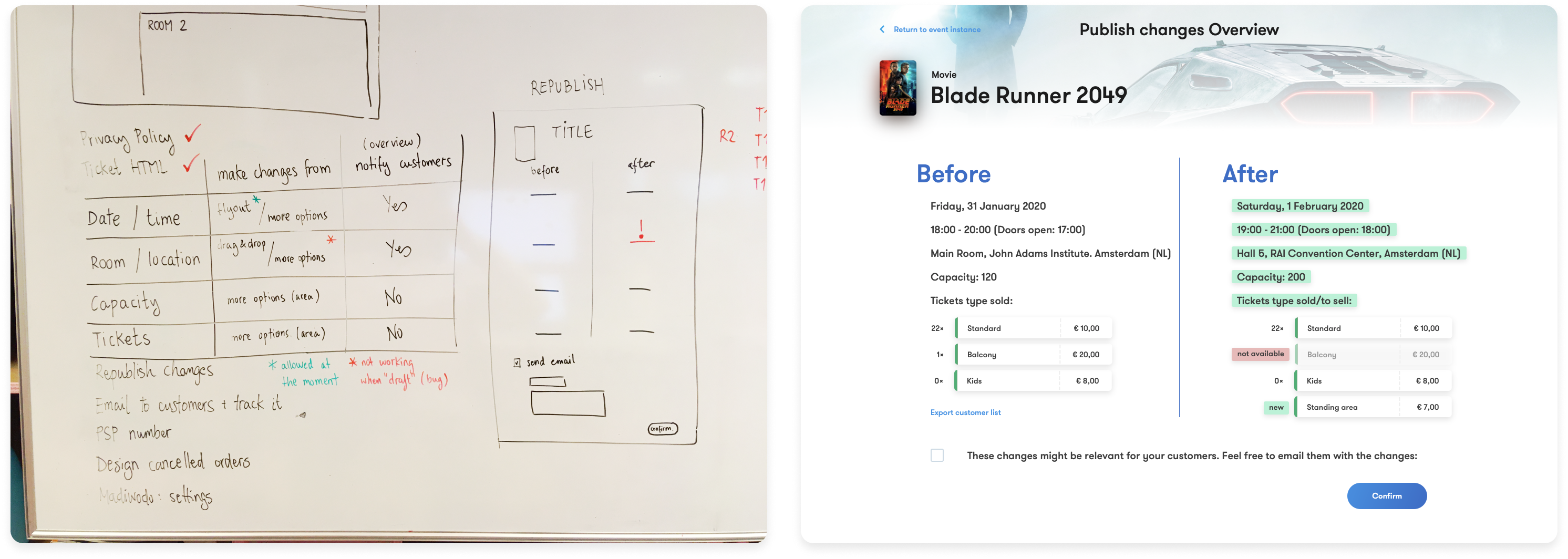
Role
Over the course of seven months, I built a component library for Beyond Tickets, whilst responding to increasing features along the way that I was happy to test afterwards.
Proposed pivoting the business model to a 6-month free version to attract new clients.
Aligned the team to use a collaborative whiteboard for a more efficient way of working.
Outcome
Shipping lots of different features for the platform Beyond Tickets.
Standardizing reusable components.
Creating a voucher system during Covid times for clients to get some income while being shut down.
Data analysis: empowering actionable metrics vs vanity metrics.
Team
Thomas Wiegerinck – Product Owner
Daniel Rodrigues – Front End
Guido van Dijk – Back End
Massimiliano Donini – Lead Developer
Anchal Pandey – Tester
Laurent Hubeek – Implementation
Carlo Pols – Product Designer
INTRO
Overview
Ticketing group was born with a notorius problem. While trying to achieve the Product – Market fit for Beyond Tickets – the B2B product I worked for – , they also put effort and resources in a B2C product called Cultuurticket that did not even accomplish the business stage Problem – Solution fit.
The cultural sector is a challenging one, since the budget oftentimes comes from public administrations. As well, it is an old-school sector where changes are unlikely to happen overnight.

Marketing banner I designed to create some synergy between our two products
PROBLEM 1
Two products. One team
Upon my arrival, some members of the team switched to Cultuurticket. After a few months, management decided to put it in the freezer. We got some EU funds and needed to onboard more clients on Beyond Tickets, so they shifted the focus again.
When Covid-19 hit Europe, businesses were trying to survive. Especially, event planning companies. Nobody would invest one euro in our B2B product, so the focus shifted back to the B2C one.
In a nutshell, many changes for a small team.
PROBLEM 2
Starting with a retrospective
Since the Design System had a few false starts, I wanted to learn more about where previous efforts came short. To do that, I talked to some members of the core product team. What I learned was that there was:
An inexistent single source of truth: there were only a couple of references product teams would confidently refer to. That was either a Storybook environment, or a mix of work in progress and production-grade components.
I always assumed there was certain resistance around adopting a Design System. I couldn’t have been more wrong. People are trying to ship, and the last thing they need is a design system throwing a wrench into the works.
Whilst going rogue enabled velocity, it soon led to statements like “Why are there four different ways of showing a modal?”. With no active maintainers, our source of truth started to become unreliable.
In short, there was a lot of housekeeping to do. And I took the lead on this unsolicited task.

Manage your venues, events, orders and customers with Beyond Tickets
BEYOND TICKETS
Business Model
Based on research, there was a Problem – Solution fit with our product in the market. Where we struggled was with the Product – Market fit. It was expected to land 40+ clients in a year. Instead, we had two, and we managed to just double that.
The business model was short-sighted, thinking that we would make money from the beginning. Instead, I stated that it would make more sense to give the product for free. WHY:
- It would be for free for a decent but limited amount of time, creating a need in the clients so they would stick to our product in the long run.
- The so much needed client feedback. From our clients, only one was giving feedback and over time everything seemed to be more custom work rather than features needed by potential clients. With 10+ “free” clients we would have seen trends, and our Roadmap would have made more sense.
- The Cost of Change for potential clients was high. Even if they were unhappy with their current ticketing solution, our pricing was not appealing.
- The product team should have stated way before that we were not in the right direction.
- From management there was more interest in merging with or being acquired by bigger players in the industry. They actually managed to do so, but due to Covid, CM.com did not move forward with any investment decision.
KUDOS FROM THE TEAM
What I built
Despite not succeeding as a company, we built cool features that we are proud of. We were an awesome and skilled TEAM. We had lots of fun and we are still in touch despite being spread over the Netherlands.
I will highlight some of the features I designed. They came after researching good practices in the industry at the same time they were tackling our clients’ needs.

Seat placement: ideation while checking how this feature affected multiple categories in our platform. Final design on the right

Intuitive matrix with user permissions: All, View only or No access. Drag & drop Users and Roles indistinctively

Change/cancel event and refund: allow clients to notify customers of the changes in their booking: time, venue, room or ticket type
TAKE AWAYS
What I've learnt
My time at Ticketing Group was splendid. We implemented Agile Methodologies that allowed us to be on the same page most of the time. Thanks to having retrospective sessions, we were always improving our way of working.
However, there are things I would do different in next professional adventures:
- With a proper piece of research, the Product Team should be the one telling Management what direction to take. And not the opposite because they have a hunch.
- Talking about research, I tried to visit potential clients but Dutch colleagues were doing so to avoid clients speaking in English. I think next time I should speak up. I am more than a pixel perfect guy.
- A product is never finished. Same applies to the Design System. It is constantly evolving and I wish I would have finished what I started.
- A multicultural team is an awesome thing to experience. I thought it was a cliché but it really does make a difference. Professionally and personally, it has been a great addition to my skillset.

